Quantitative Assessment of the Impact of the Three-North Shelter Forest Program on Vegetation Net Primary Productivity over the Past Two Decades and Its Environmental Benefits in China
Abstract
:1. Introduction
2. Materials and Methods
2.1. Research Area
2.2. Data Sources
2.2.1. Net Primary Productivity (NPP) Data
2.2.2. Meteorological Data
2.2.3. Land Use and Land Cover (LULC) Data
2.2.4. Data Environmental Quality Data
2.3. Research Methods
2.3.1. Data Correlation Analysis
2.3.2. Trend Analysis
2.3.3. Mann–Kendall Significance Test
2.3.4. Residual Trend Analysis
3. Results
3.1. Temporal and Spatial Variations in NPP within the TNSFP Area from 2001 to 2020
3.2. Impact of Climate Change on NPP within the TNSFP Area from 2001 to 2020
3.3. Influence of Human Activities on NPP within the TNSFP Area from 2001 to 2020
3.4. Environmental Benefits of the TNSFP Area
4. Discussion
4.1. The Influence of Climate Change on Vegetation NPP
4.2. The Influence of Human Activities on Vegetation NPP
4.3. Impact of Ecological Engineering on Vegetation NPP
5. Conclusions
Supplementary Materials
Author Contributions
Funding
Institutional Review Board Statement
Informed Consent Statement
Data Availability Statement
Acknowledgments
Conflicts of Interest
References
- Elahi, E.; Li, G.; Han, X.; Zhu, W.; Liu, Y.; Cheng, A.; Yang, Y. Decoupling livestock and poultry pollution emissions from industrial development: A step towards reducing environmental emissions. J. Environ. Manag. 2024, 350, 119654. [Google Scholar] [CrossRef] [PubMed]
- Abbas, A.; Waseem, M.; Ahmad, R.; Khan, K.A.; Zhao, C.; Zhu, J. Sensitivity analysis of greenhouse gas emissions at farm level: Case study of grain and cash crops. Environ. Sci. Pollut. Res. 2022, 29, 82559–82573. [Google Scholar] [CrossRef] [PubMed]
- Chen, L.; Halike, A.; Yao, K.; Wei, Q. Spatiotemporal variation in vegetation net primary productivity and its relationship with meteorological factors in the Tarim River Basin of China from 2001 to 2020 based on the Google Earth Engine. J. Arid Land 2022, 14, 1377–1394. [Google Scholar] [CrossRef]
- Zhao, M.; Running, S.W. Drought-Induced Reduction in Global Terrestrial Net Primary Production from 2000 through 2009. Science 2010, 329, 940–943. [Google Scholar] [CrossRef] [PubMed]
- Chen, Z.; Chen, J.; Xu, G.; Sha, Z.; Yin, J.; Li, Z. Estimation and Climate Impact Analysis of Terrestrial Vegetation Net Primary Productivity in China from 2001 to 2020. Land 2023, 12, 1223. [Google Scholar] [CrossRef]
- Bejagam, V.; Sharma, A.; Wei, X. Projected decline in the strength of vegetation carbon sequestration under climate change in India. Sci. Total Environ. 2024, 916, 170166. [Google Scholar] [CrossRef]
- Melillo, J.M.; McGuire, A.D.; Kicklighter, D.W.; Moore, B.; Vorosmarty, C.J.; Schloss, A.L. Global climate change and terrestrial net primary production. Nature 1993, 363, 234–240. [Google Scholar] [CrossRef]
- Shao, Y.; Zhu, Q.; Feng, Z.; Sun, L.; Yang, X.; Li, X.; Wang, A.; Yang, F.; Ji, H. Temporal and Spatial Assessment of Carbon Flux Dynamics: Evaluating Emissions and Sequestration in the Three Northern Protection Forest Project Areas Supported by Google Earth Engine. Remote Sens. 2024, 16, 777. [Google Scholar] [CrossRef]
- Zhang, C.; Zhen, H.; Zhang, S.; Tang, C. Dynamic changes in net primary productivity of marsh wetland vegetation in China from 2005 to 2015. Ecol. Indic. 2023, 155, 110970. [Google Scholar] [CrossRef]
- Zhu, W.; Chen, Y.; Xu, D.; Li, J. Research Progress on Calculation Models of Terrestrial Vegetation Net Primary Productivity. J. Ecol. 2005, 24, 296–300. (In Chinese) [Google Scholar]
- Boisvenue, C.; Running, S.W. Impacts of climate change on natural forest productivity—Evidence since the middle of the 20th century. Glob. Chang. Biol. 2006, 12, 862–882. [Google Scholar] [CrossRef]
- Xu, Y.; Lu, Y.; Zou, B.; Xu, M.; Feng, Y. Unraveling the enigma of NPP variation in Chinese vegetation ecosystems: The interplay of climate change and land use change. Sci. Total Environ. 2024, 912, 169023. [Google Scholar] [CrossRef] [PubMed]
- Bennett, A.C.; Knauer, J.; Bennett, L.T.; Haverd, V.; Arndt, S.K. Variable influence of photosynthetic thermal acclimation on future carbon uptake in Australian wooded ecosystems under climate change. Glob. Chang. Biol. 2024, 30, e17021. [Google Scholar] [CrossRef] [PubMed]
- Yin, S.; Du, H.; Mao, F.; Li, X.; Zhou, G.; Xu, C.; Sun, J. Spatiotemporal patterns of net primary productivity of subtropical forests in China and its response to drought. Sci. Total Environ. 2024, 913, 169439. [Google Scholar] [CrossRef]
- Wang, Y.; Shen, X.; Jiang, M.; Tong, S.; Lu, X. Daytime and nighttime temperatures exert different effects on vegetation net primary productivity of marshes in the western Songnen Plain. Ecol. Indic. 2022, 137, 108789. [Google Scholar] [CrossRef]
- Wilcox, K.R.; Shi, Z.; Gherardi, L.A.; Lemoine, N.P.; Koerner, S.E.; Hoover, D.L.; Bork, E.; Byrne, K.M.; Cahill, J.; Collins, S.L.; et al. Asymmetric responses of primary productivity to precipitation extremes: A synthesis of grassland precipitation manipulation experiments. Glob. Chang. Biol. 2017, 23, 4376–4385. [Google Scholar] [CrossRef] [PubMed]
- Wen, Y.; Cai, H.; Han, D. Driving factors analysis of spatial–temporal evolution of vegetation ecosystem in rocky desertification restoration area of Guizhou Province, China. Environ. Sci. Pollut. Res. 2024, 31, 13122–13140. [Google Scholar] [CrossRef] [PubMed]
- Chen, X.; Zhang, Y. The impact of vegetation phenology changes on the relationship between climate and net primary productivity in Yunnan, China, under global warming. Front. Plant Sci. 2023, 14, 1248482. [Google Scholar] [CrossRef] [PubMed]
- Xu, M.; Zhang, Z.; Wang, Y.; Liu, B. Quantifying the contributions of climatic and human factors to vegetation net primary productivity dynamics in East Africa. Front. For. Glob. Chang. 2024, 6, 1332631. [Google Scholar] [CrossRef]
- Das, R.; Chaturvedi, R.K.; Roy, A.; Karmakar, S.; Ghosh, S. Warming inhibits increases in vegetation net primary productivity despite greening in India. Sci. Rep. 2023, 13, 21309. [Google Scholar] [CrossRef]
- Fu, Y.; Zhou, Z.; Li, J.; Zhang, S. Impact of Aerosols on NPP in Basins: Case Study of WRF–Solar in the Jinghe River Basin. Remote Sens. 2023, 15, 1908. [Google Scholar] [CrossRef]
- Zhou, A.; Xiang, W.; Yao, Y.; Huang, F.; Li, X. Spatial-temporal evolution and main influencing factors analysis of Net Primary Productivity (NPP) in Guangxi vegetation. Guangxi Plants 2014, 34, 622–628. (In Chinese) [Google Scholar]
- Mu, S.; Li, J.; Zhou, W.; Yang, H.; Zhang, C.; Ju, W. Spatial-temporal patterns of vegetation net primary productivity and its relationship with climate in Inner Mongolia from 2001 to 2010. Acta Ecol. Sin. 2013, 33, 3752–3764. (In Chinese) [Google Scholar]
- Xu, S.; Zhang, M.; Su, M. Spatial-temporal evolution characteristics of Net Primary Productivity (NPP) of grassland on the Qinghai-Tibet Plateau under future climate scenarios. Res. Soil Water Conserv. 2024, 31, 190–201. (In Chinese) [Google Scholar]
- Zhang, Y.; Zhang, C.; Wang, Z.; Chen, Y.; Gang, C.; An, R.; Li, J. Vegetation dynamics and its driving forces from climate change and human activities in the Three-River Source Region, China from 1982 to 2012. Sci. Total Environ. 2016, 563–564, 210–220. [Google Scholar] [CrossRef] [PubMed]
- Liu, Y.; Wang, X.; Xin, L.; Lu, Y. Impact of Farmland Change on Vegetation NPP in the One River and Two Streams Region of Tibet. Land 2022, 11, 2223. [Google Scholar] [CrossRef]
- Luck, G.W. The relationships between net primary productivity, human population density and species conservation. J. Biogeogr. 2007, 34, 201–212. [Google Scholar] [CrossRef]
- Xue, H.; Chen, Y.; Dong, G.; Li, J. Quantitative analysis of spatiotemporal changes and driving forces of vegetation net primary productivity (NPP) in the Qimeng region of Inner Mongolia. Ecol. Indic. 2023, 154, 110610. [Google Scholar] [CrossRef]
- Hao, X.; Wang, X.; Ma, J.; Chen, Y.; Luo, S. Spatiotemporal Characteristic Prediction and Driving Factor Analysis of Vegetation Net Primary Productivity in Central China Covering the Period of 2001–2019. Land 2023, 12, 2121. [Google Scholar] [CrossRef]
- Liang, W.; Quan, Q.; Wu, B.; Mo, S. Response of Vegetation Dynamics in the Three-North Region of China to Climate and Human Activities from 1982 to 2018. Sustainability 2023, 15, 3073. [Google Scholar] [CrossRef]
- Cai, Y.; Liu, X.; Liu, K.; Zeng, L.; Pei, F.; Zhuang, H.; Wen, Y.; Wu, C.; Li, B. Human activities significantly impact China’s net primary production variation from 2001 to 2020. Prog. Phys. Geogr. Earth Environ. 2023, 48, 251–274. [Google Scholar] [CrossRef]
- Li, W.; Zhou, J.; Xu, Z.; Liang, Y.; Shi, J.; Zhao, X. Climate impact greater on vegetation NPP but human enhance benefits after the Grain for Green Program in Loess Plateau. Ecol. Indic. 2023, 157, 111201. [Google Scholar] [CrossRef]
- Ji, P.; Shao, Q.; Wang, M.; Liu, H.; Wang, X.; Ling, C.; Hou, R. Comprehensive evaluation of ecological benefits of the second phase of the Three-North Shelter Forest Program in China. For. Sci. 2022, 58, 31–48. (In Chinese) [Google Scholar]
- Yu, H.; Ding, Q.; Meng, B.; Lv, Y.; Liu, C.; Zhang, X.; Sun, Y.; Li, M.; Yi, S. The Relative Contributions of Climate and Grazing on the Dynamics of Grassland NPP and PUE on the Qinghai-Tibet Plateau. Remote Sens. 2021, 13, 3424. [Google Scholar] [CrossRef]
- Liu, Y.; Zhang, Z.; Tong, L.; Khalifa, M.; Wang, Q.; Gang, C.; Wang, Z.; Li, J.; Sun, Z. Assessing the effects of climate variation and human activities on grassland degradation and restoration across the globe. Ecol. Indic. 2019, 106, 105504. [Google Scholar] [CrossRef]
- Zhang, Y.; Wang, Q.; Wang, Z.; Yang, Y.; Li, J. Impact of human activities and climate change on the grassland dynamics under different regime policies in the Mongolian Plateau. Sci. Total Environ. 2020, 698, 134304. [Google Scholar] [CrossRef] [PubMed]
- Gong, H.; Cao, L.; Duan, Y.; Jiao, F.; Xu, X.; Zhang, M.; Wang, K.; Liu, H. Multiple effects of climate changes and human activities on NPP increase in the Three-north Shelter Forest Program area. Forest Ecol. Manag. 2023, 529, 120732. [Google Scholar] [CrossRef]
- Chen, S.; Ma, M.; Wu, S.; Tang, Q.; Wen, Z. Topography intensifies variations in the effect of human activities on forest NPP across altitude and slope gradients. Environ. Dev. 2023, 45, 100826. [Google Scholar] [CrossRef]
- Zhao, C.; Yan, Y.; Ma, W.; Shang, X.; Chen, J.; Rong, Y.; Xie, T.; Quan, Y. RESTREND-based assessment of factors affecting vegetation dynamics on the Mongolian Plateau. Ecol. Model. 2021, 440, 109415. [Google Scholar] [CrossRef]
- Li, Q.; Zhang, C.; Shen, Y.; Jia, W.; Li, J. Quantitative assessment of the relative roles of climate change and human activities in desertification processes on the Qinghai-Tibet Plateau based on net primary productivity. Catena 2016, 147, 789–796. [Google Scholar] [CrossRef]
- He, C.; Tian, J.; Gao, B.; Zhao, Y. Differentiating climate- and human-induced drivers of grassland degradation in the Liao River Basin, China. Environ. Monit. Assess. 2015, 187, 4199. [Google Scholar] [CrossRef]
- Shao, Y.; Liu, Y.; Ma, T.; Sun, L.; Yang, X.; Li, X.; Wang, A.; Wang, Z. Conservation Effectiveness Assessment of the Three Northern Protection Forest Project Area. Forests 2023, 14, 2121. [Google Scholar] [CrossRef]
- Zhang, D.; Zuo, X.; Zang, C. Assessment of future potential carbon sequestration and water consumption in the construction area of the Three-North Shelterbelt Programme in China. Agric. For. Meteorol. 2021, 303, 108377. [Google Scholar] [CrossRef]
- Zheng, X.; Zhu, J.; Xing, Z. Assessment of the effects of shelterbelts on crop yields at the regional scale in Northeast China. Agric. Syst. 2016, 143, 49–60. [Google Scholar] [CrossRef]
- Mu, H.; Li, X.; Ma, H.; Du, X.; Huang, J.; Su, W.; Yu, Z.; Xu, C.; Liu, H.; Yin, D.; et al. Evaluation of the policy-driven ecological network in the Three-North Shelterbelt region of China. Landscape Urban Plan. 2022, 218, 104305. [Google Scholar] [CrossRef]
- Wu, Y.; Wang, W.; Wang, Q.; Zhong, Z.; Pei, Z.; Wang, H.; Yao, Y. Impact of poplar shelterbelt plantations on surface soil properties in northeastern China. Can. J. For. Res. 2018, 48, 559–567. [Google Scholar] [CrossRef]
- Wu, Y.; Wang, W.; Wang, Q.; Zhong, Z.; Wang, H.; Yang, Y. Farmland Shelterbelt Changes in Soil Properties: Soil Depth-Location Dependency and General Pattern in Songnen Plain, Northeastern China. Forests 2023, 14, 584. [Google Scholar] [CrossRef]
- Peng, S.; Ding, Y.; Liu, W.; Li, Z. 1 km monthly temperature and precipitation dataset for China from 1901 to 2017. Earth Syst. Sci. Data 2019, 11, 1931–1946. [Google Scholar] [CrossRef]
- GB/T 21010-2017; Classification of Land Use Status. China Standards Press: Beijing, China, 2017.
- Wei, J.; Li, Z.; Lyapustin, A.; Sun, L.; Peng, Y.; Xue, W.; Su, T.; Cribb, M. Reconstructing 1-km-resolution high-quality PM2.5 data records from 2000 to 2018 in China: Spatiotemporal variations and policy implications. Remote Sens. Environ. 2021, 252, 112136. [Google Scholar] [CrossRef]
- Wu, D.; Shao, Q.; Liu, J.; Cao, W. Spatial and Temporal Changes of Water Conservation Services in China’s Grassland Ecosystems. Water Soil Conserv. Res. 2016, 23, 256–260. (In Chinese) [Google Scholar] [CrossRef]
- Wang, Q.; Liang, L.; Wang, S.; Wang, S.; Zhang, L.; Qiu, S.; Shi, Y.; Shi, J.; Sun, C. Insights into Spatiotemporal Variations in the NPP of Terrestrial Vegetation in Africa from 1981 to 2018. Remote Sens. 2023, 15, 2748. [Google Scholar] [CrossRef]
- Yang, A.; Zhang, X.; Li, Z.; Li, Y.; Nan, F. Quantitative analysis of the impacts of climate change and human activities on vegetation NPP in the Qilian Mountain National Park. Acta Ecol. Sin. 2023, 43, 1784. [Google Scholar]
- Chi, D.; Wang, H.; Li, X.; Liu, H.; Li, X. Assessing the effects of grazing on variations of vegetation NPP in the Xilingol Grassland, China, using a grazing pressure index. Ecol. Indic. 2018, 88, 372–383. [Google Scholar] [CrossRef]
- Xuan, W.; Rao, L. Spatiotemporal dynamics of net primary productivity and its influencing factors in the middle reaches of the Yellow River from 2000 to 2020. Front. Plant Sci. 2023, 14, 1043807. [Google Scholar] [CrossRef]
- Shao, Q.; Fan, J.; Liu, J.; Yang, F.; Liu, H.; Yang, X.; Xu, M.; Hou, P.; Guo, X.; Huang, L.; et al. Study on Monitoring and Evaluation of Ecological Benefits of Major Ecological Projects. Adv. Earth Sci. 2017, 32, 1174–1182. (In Chinese) [Google Scholar]
- Sun, Y.; Feng, Y.; Wang, Y.; Zhao, X.; Yang, Y.; Tang, Z.; Wang, S.; Su, H.; Zhu, J.; Chang, J.; et al. Field-Based Estimation of Net Primary Productivity and Its Above- and Belowground Partitioning in Global Grasslands. J. Geophys. Res. Biogeosci. 2021, 126, e2021JG006472. [Google Scholar] [CrossRef]
- Zhang, C.; Ren, W. Complex climatic and CO2 controls on net primary productivity of temperate dryland ecosystems over central Asia during 1980–2014. J. Geophys. Res. Biogeosci. 2017, 122, 2356–2374. [Google Scholar] [CrossRef]
- Felton, A.J.; Shriver, R.K.; Bradford, J.B.; Suding, K.N.; Allred, B.W.; Adler, P.B. Biotic vs abiotic controls on temporal sensitivity of primary production to precipitation across North American drylands. New Phytol. 2021, 231, 2150–2161. [Google Scholar] [CrossRef] [PubMed]
- Wang, Y.; Hessen, D.O.; Samset, B.H.; Stordal, F. Evaluating global and regional land warming trends in the past decades with both MODIS and ERA5-Land land surface temperature data. Remote Sens. Environ. 2022, 280, 113181. [Google Scholar] [CrossRef]
- Konecky, B.L.; McKay, N.P.; Falster, G.M.; Stevenson, S.L.; Fischer, M.J.; Atwood, A.R.; Thompson, D.M.; Jones, M.D.; Tyler, J.J.; DeLong, K.L.; et al. Globally coherent water cycle response to temperature change during the past two millennia. Nat. Geosci. 2023, 16, 997–1004. [Google Scholar] [CrossRef]
- An, H.; Zhai, J.; Song, X.; Wang, G.; Zhong, Y.; Zhang, K.; Sun, W. Impacts of Extreme Precipitation and Diurnal Temperature Events on Grassland Productivity at Different Elevations on the Plateau. Remote Sens. 2024, 16, 317. [Google Scholar] [CrossRef]
- Murray Tortarolo, G.; Friedlingstein, P.; Sitch, S.; Seneviratne, S.I.; Fletcher, I.; Mueller, B.; Greve, P.; Anav, A.; Liu, Y.; Ahlström, A.; et al. The dry season intensity as a key driver of NPP trends. Geophys. Res. Lett. 2016, 43, 2632–2639. [Google Scholar] [CrossRef]
- Liu, Y.; Yang, Y.; Wang, Q.; Du, X.; Li, J.; Gang, C.; Zhou, W.; Wang, Z. Evaluating the responses of net primary productivity and carbon use efficiency of global grassland to climate variability along an aridity gradient. Sci. Total Environ. 2019, 652, 671–682. [Google Scholar] [CrossRef] [PubMed]
- Li, Q.; Zhang, X.; Liu, Q.; Liu, Y.; Ding, Y.; Zhang, Q. Impact of Land Use Intensity on Ecosystem Services: An Example from the Agro-Pastoral Ecotone of Central Inner Mongolia. Sustainability 2017, 9, 1030. [Google Scholar] [CrossRef]
- Zhang, X.; Nian, L.; Liu, X.; Samuel, A.; Yang, Y.; Li, X.; Liu, X.; Zhang, M.; Hui, C.; Wang, Q. The spatiotemporal response of photosynthetic accumulation per leaf area to climate change on alpine grassland. Glob. Ecol. Conserv. 2023, 43, e2467. [Google Scholar] [CrossRef]
- Jiang, Y.; Hou, W.; Gao, J.; Wu, S. Refined revealing the chain path of multiple ecosystem services under diverse environmental factor gradients. Sci. Total Environ. 2023, 865, 161187. [Google Scholar] [CrossRef]
- Hao, H.; Li, Z.; Chen, Y.; Xu, J.; Li, S.; Zhang, S. Recent variations in soil moisture use efficiency (SMUE) and its influence factors in Asian drylands. J. Clean. Prod. 2022, 373, 133860. [Google Scholar] [CrossRef]
- Huang, Q.; Zhang, F.; Zhang, Q.; Ou, H.; Jin, Y. Quantitative Assessment of the Impact of Human Activities on Terrestrial Net Primary Productivity in the Yangtze River Delta. Sustainability 2020, 12, 1697. [Google Scholar] [CrossRef]
- Deng, S.; Beale, C.M.; Platts, P.J.; Thomas, C.D. Human modification of land cover alters net primary productivity, species richness and their relationship. Glob. Ecol. Biogeogr. 2023, 33, 385–399. [Google Scholar] [CrossRef]
- Chi, Y.; Shi, H.; Zheng, W.; Sun, J.; Fu, Z. Spatiotemporal characteristics and ecological effects of the human interference index of the Yellow River Delta in the last 30 years. Ecol. Indic. 2018, 89, 880–892. [Google Scholar] [CrossRef]
- Huang, L.; Zhu, P.; Xiao, T.; Cao, W.; Gong, G. Windbreak and sand fixation effects of the Three-North Shelterbelt Project in the past 35 years. Sci. Geogr. Sin. 2018, 38, 600–609. (In Chinese) [Google Scholar]
- Zhu, J.; Zheng, X. Reflections and Prospects on the Construction of the Three-North Shelterbelt System: Based on a Comprehensive Assessment of 40 Years of Construction. J. Ecol. 2019, 38, 1600–1610. (In Chinese) [Google Scholar]
- Zhao, H.; Liu, X.; Liu, G.; Fu, H.; Zhang, Y.; Du, S.; Jiang, J.; Guo, W.; Yang, Z. Spatiotemporal variation of net primary productivity (NPP) in the Beijing-Tianjin Sand Source Area and its response to the implementation of control projects. Acta Ecol. Sin. 2024, 44, 2406–2419. (In Chinese) [Google Scholar] [CrossRef]
- Niu, L.; Shao, Q.; Ning, J.; Liu, S.; Zhang, X.; Zhang, T. The assessment of ecological restoration effects on Beijing-Tianjin Sandstorm Source Control Project area during 2000–2019. Ecol. Eng. 2023, 186, 106831. [Google Scholar] [CrossRef]
- Wang, L.; Cao, W.; Huang, L. Integrated analysis of ecological effects of major ecological projects in China over the past 40 years. Acta Ecol. Sin. 2024, 7, 1–15. (In Chinese) [Google Scholar] [CrossRef]
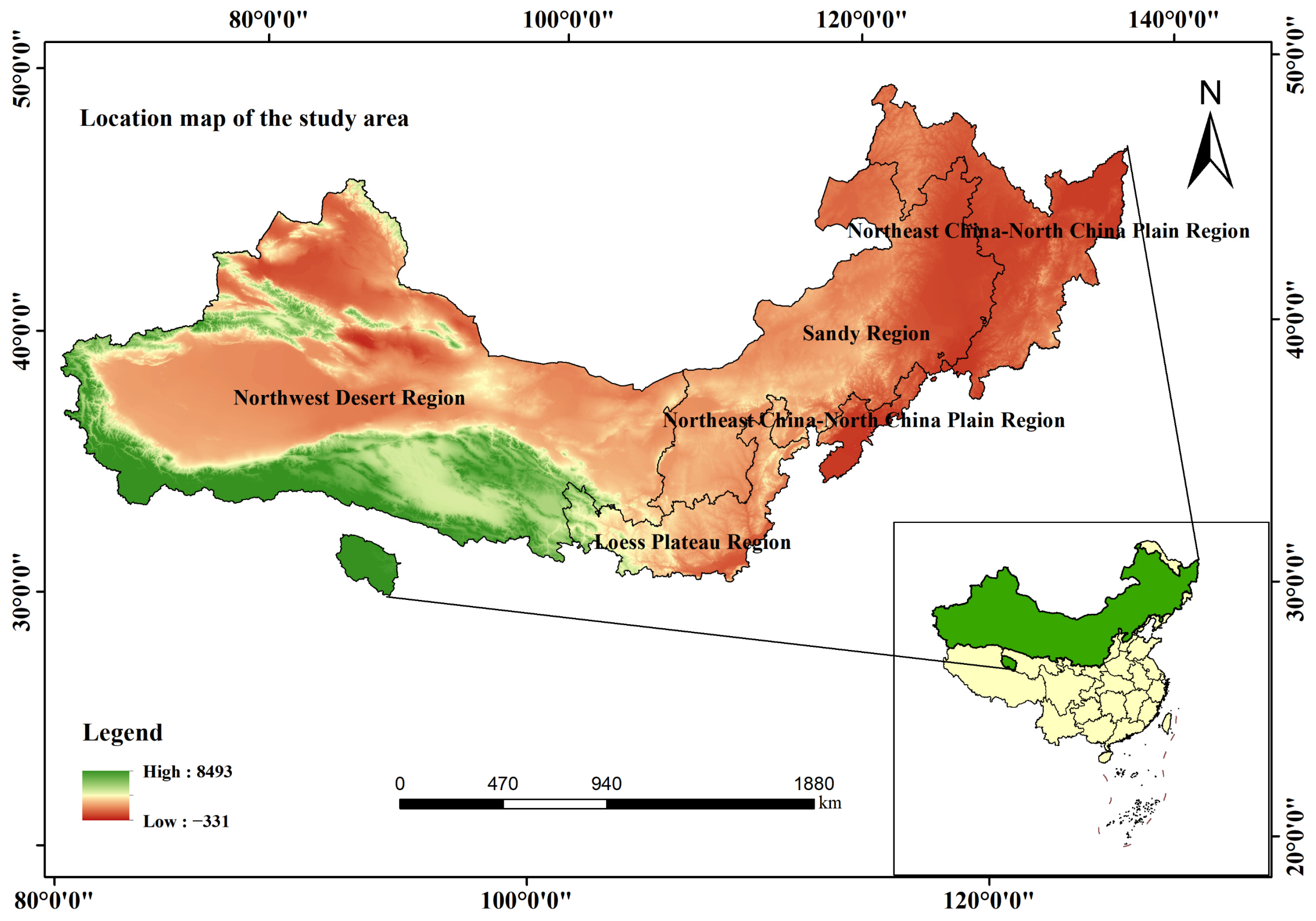

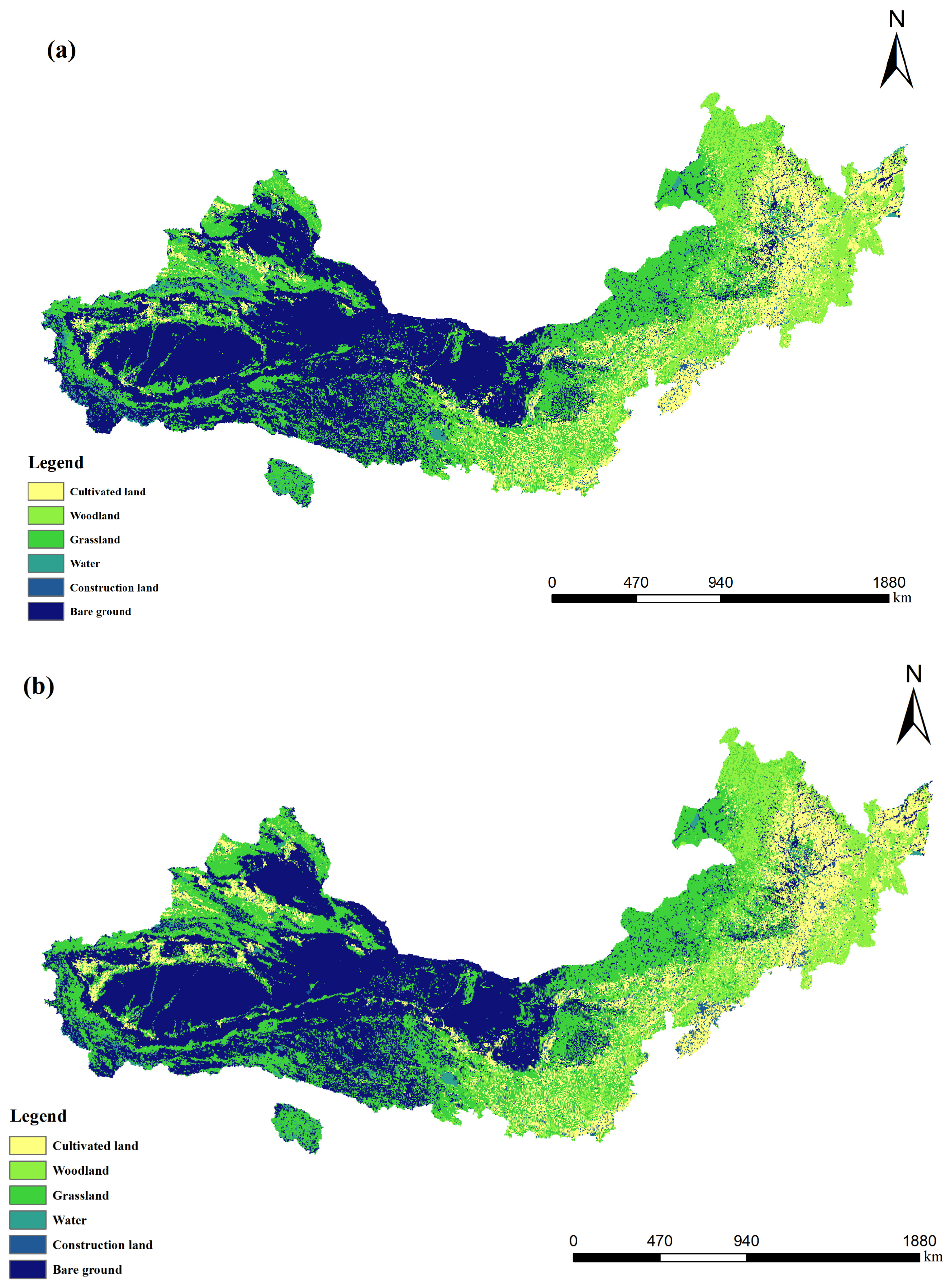
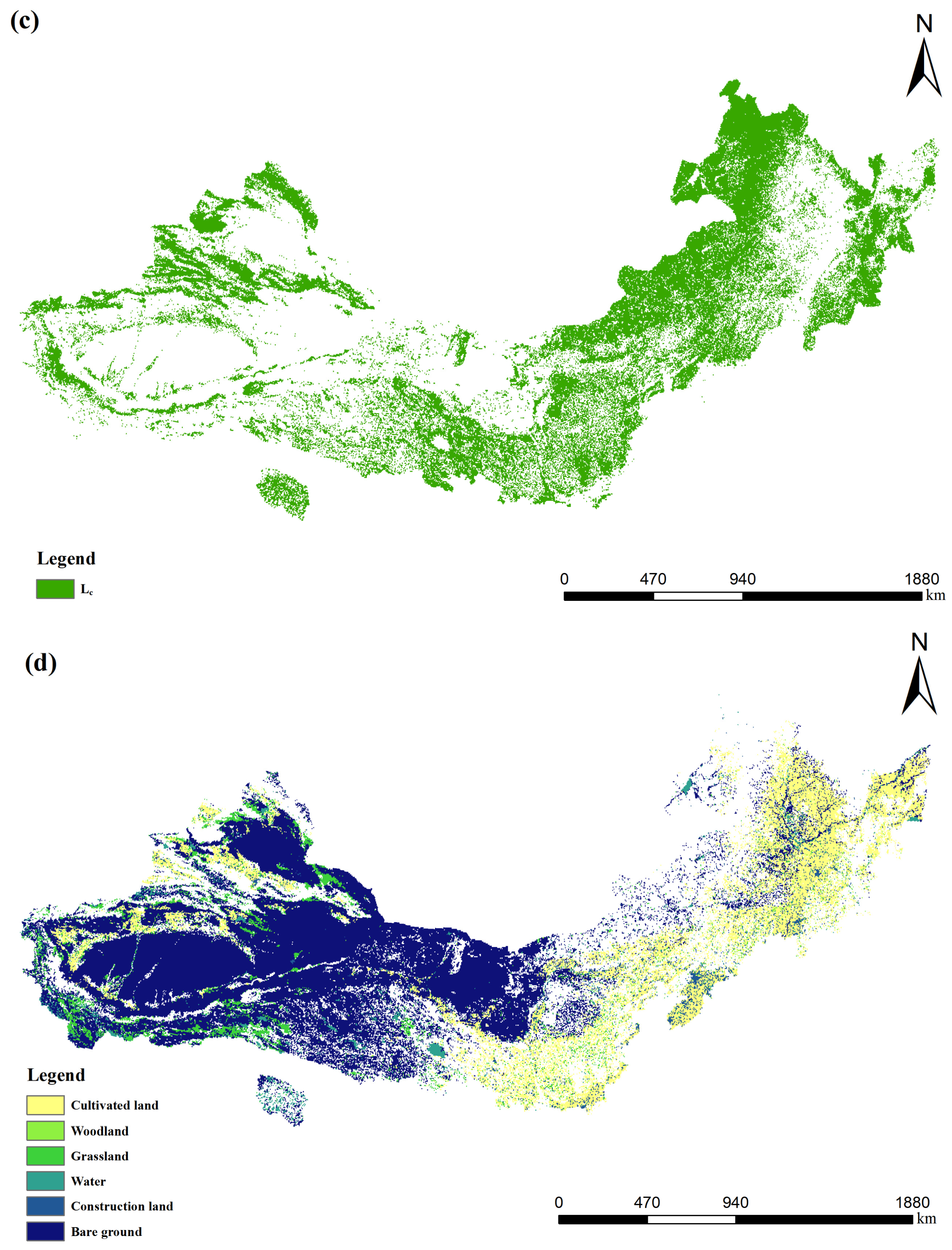
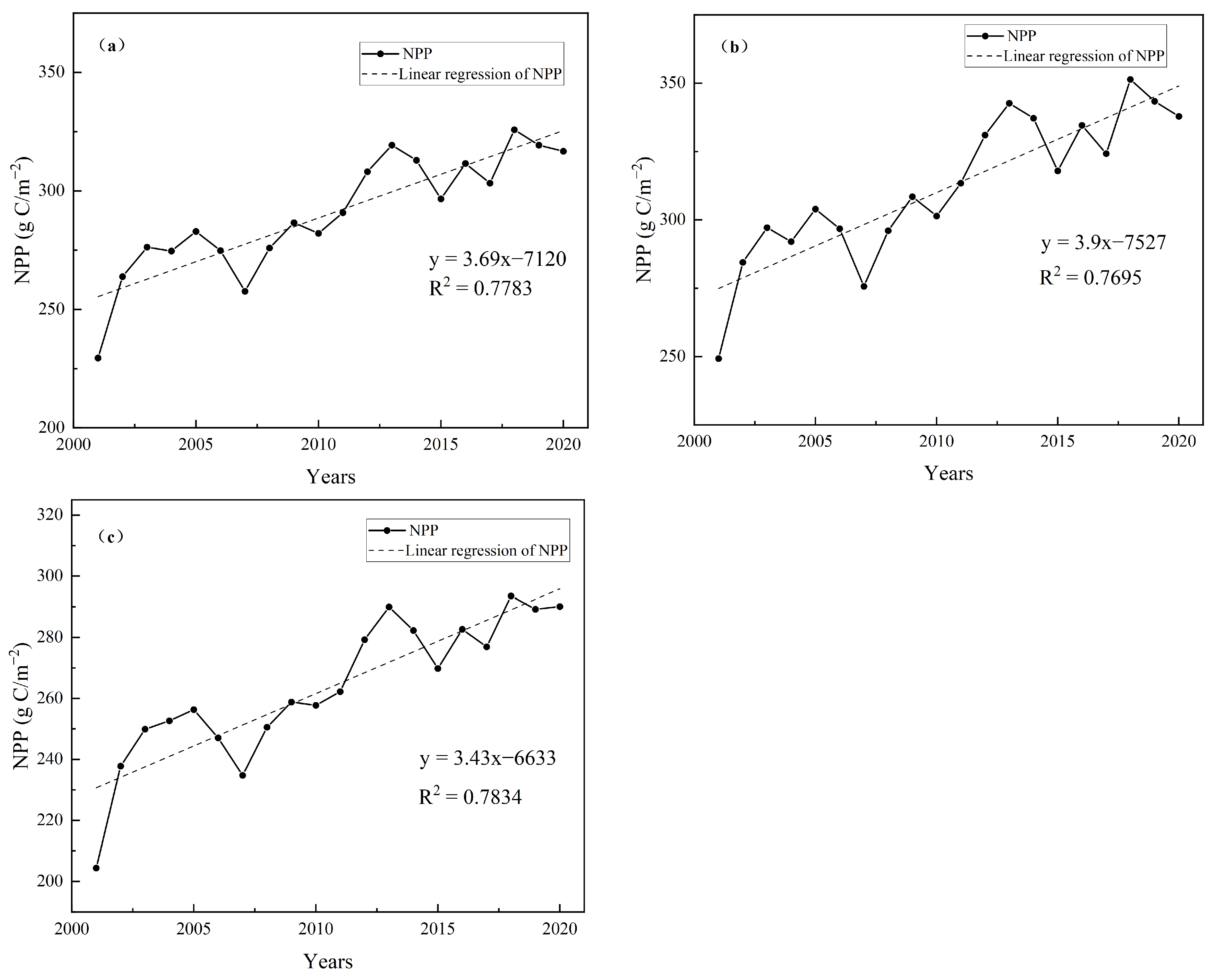
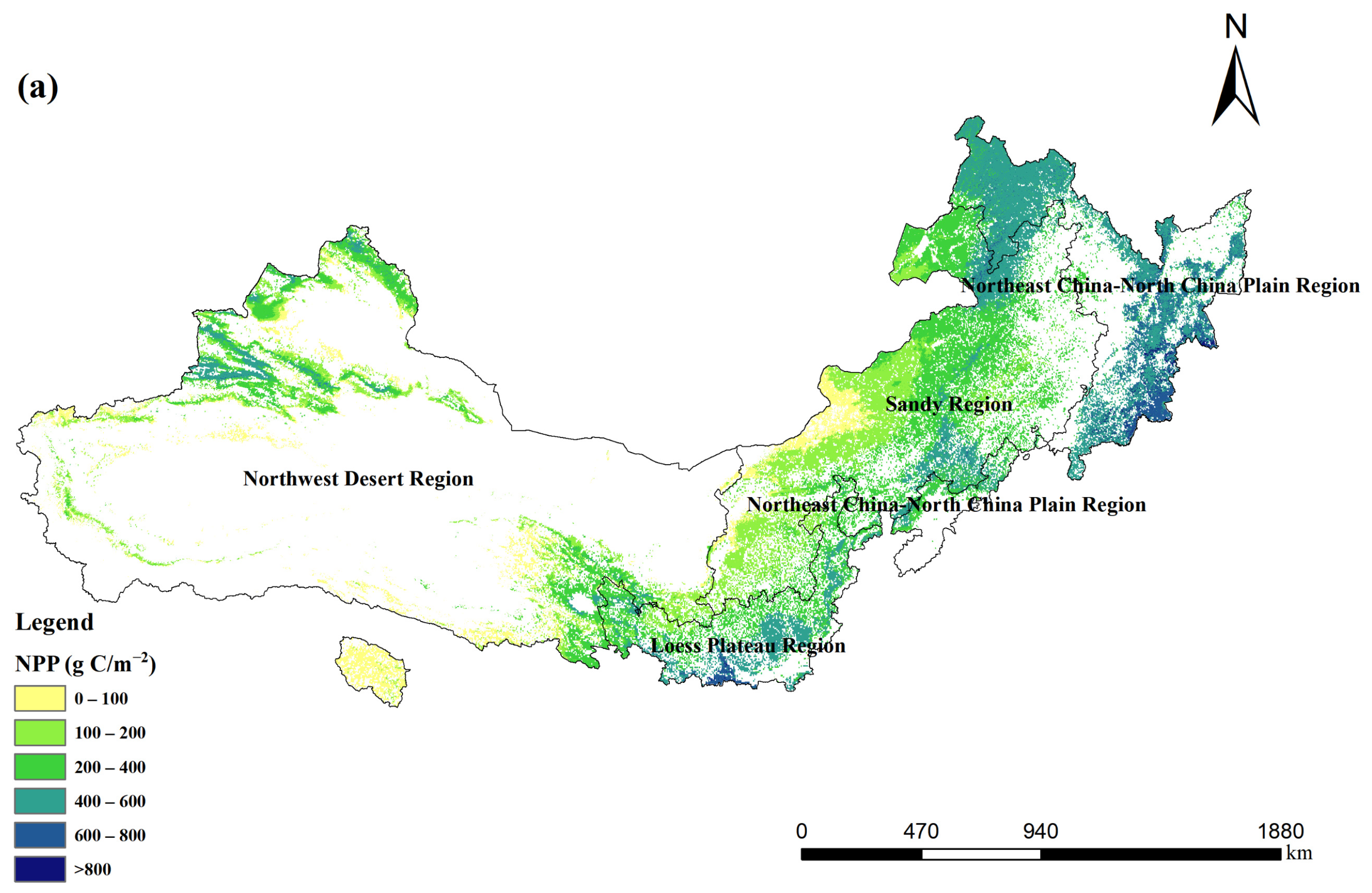
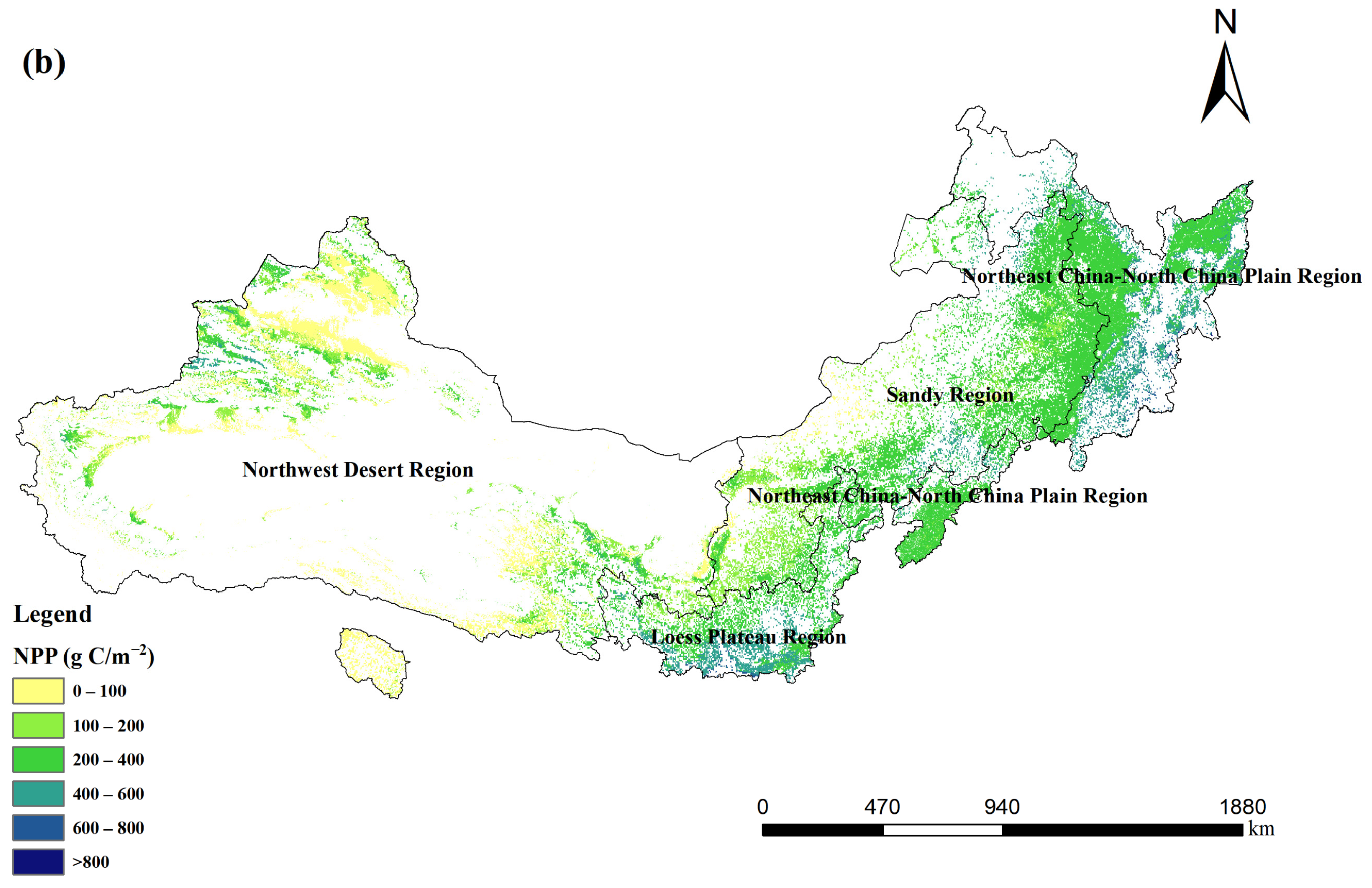
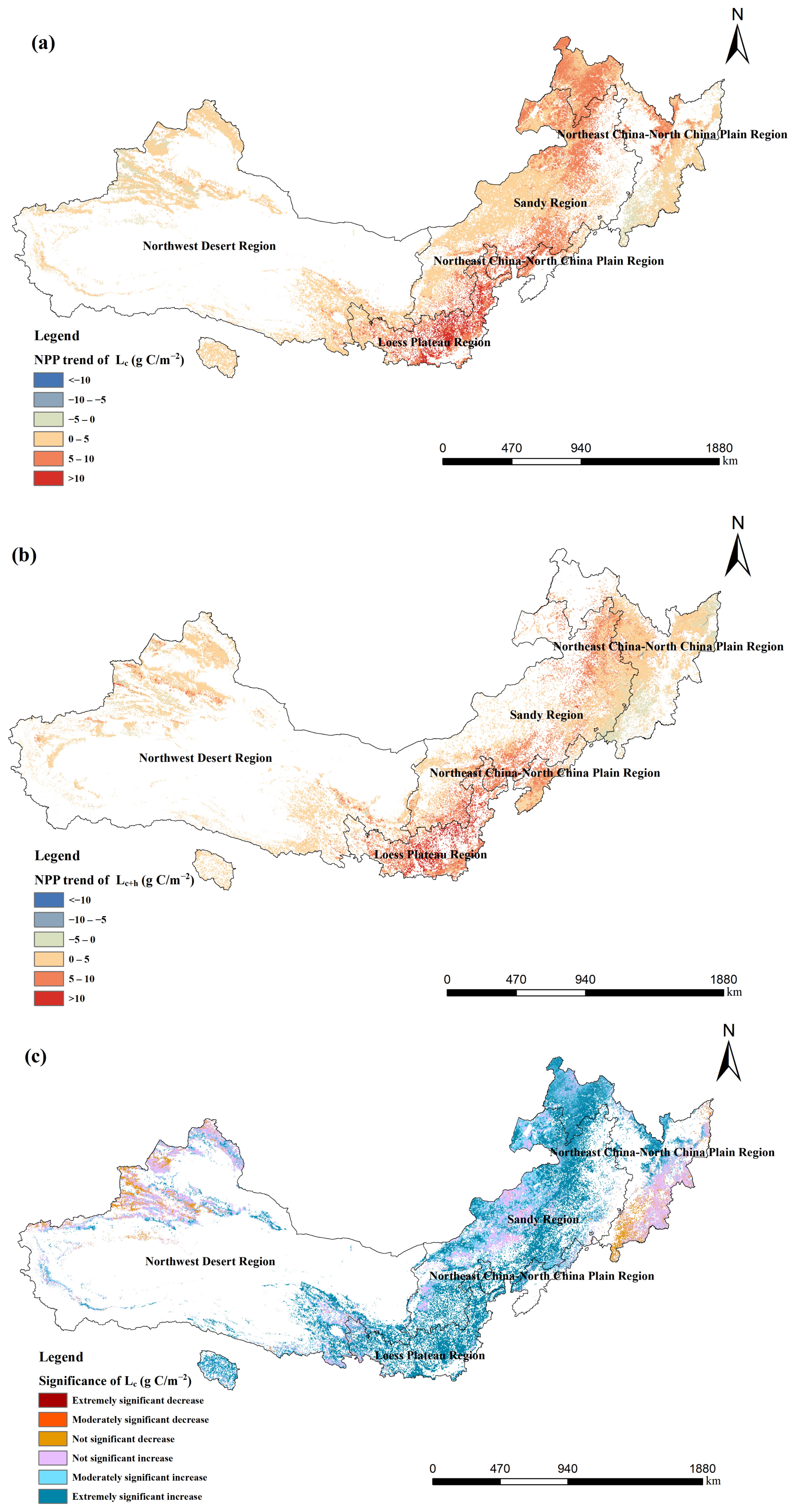

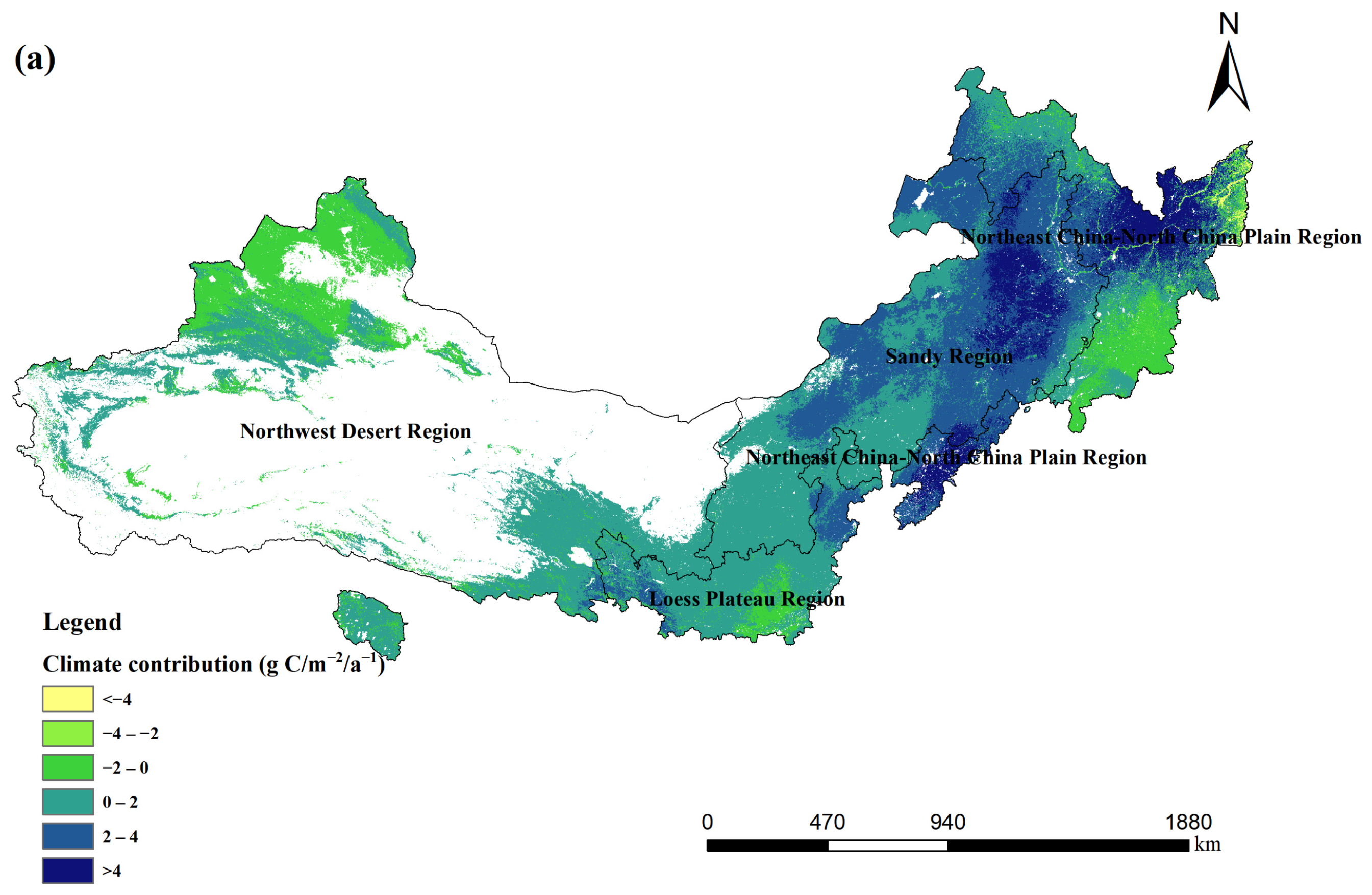

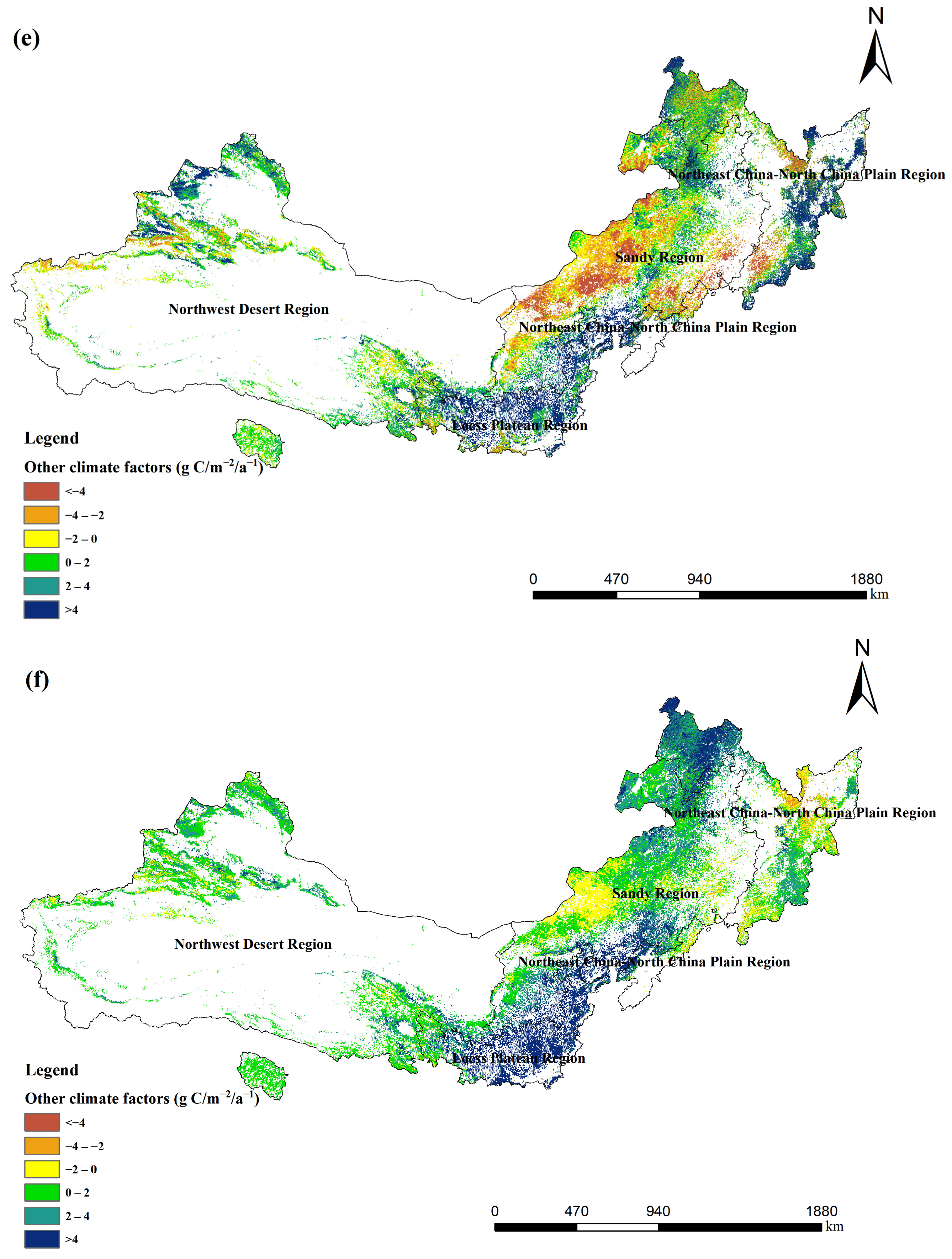
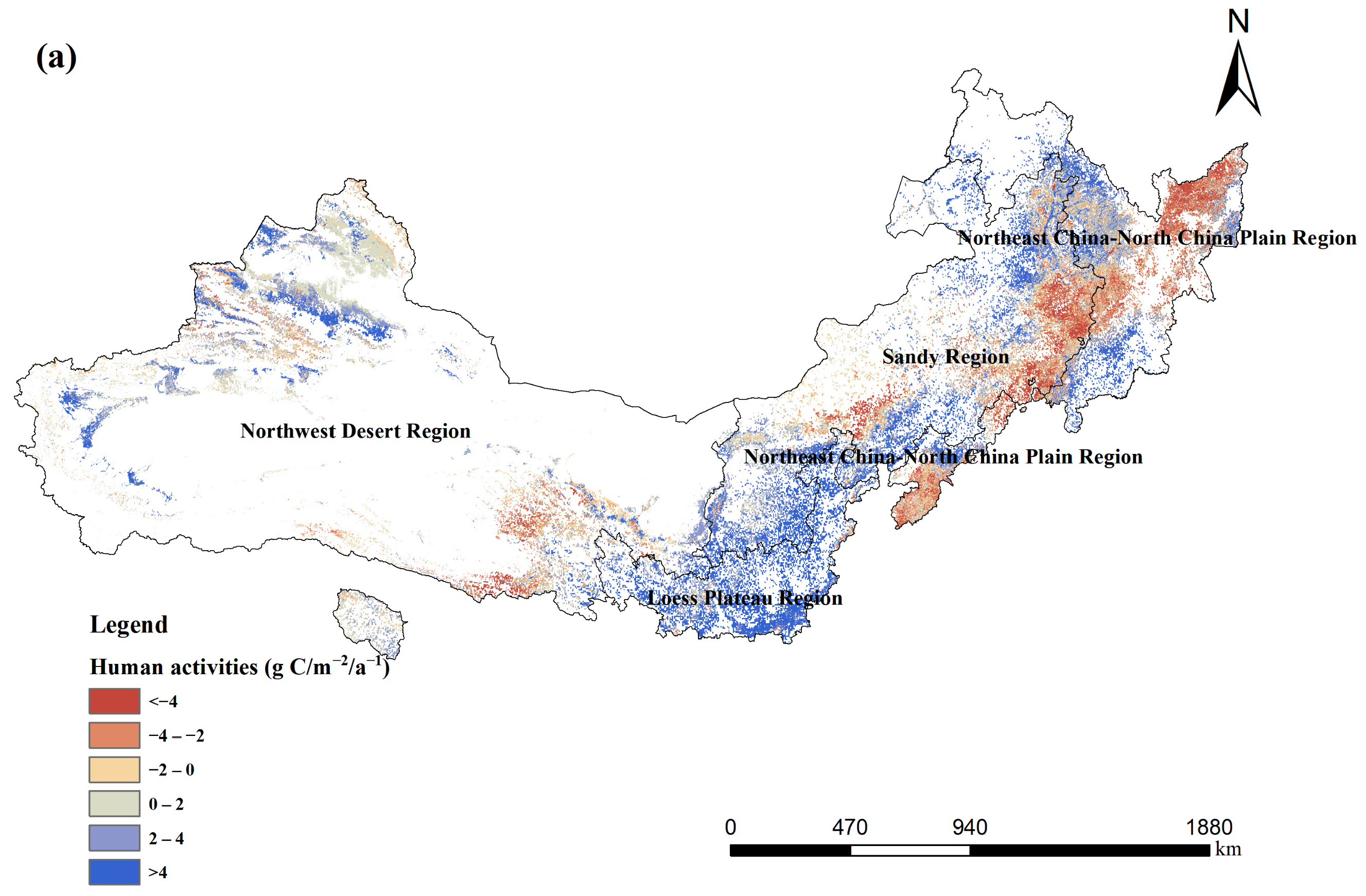

Disclaimer/Publisher’s Note: The statements, opinions and data contained in all publications are solely those of the individual author(s) and contributor(s) and not of MDPI and/or the editor(s). MDPI and/or the editor(s) disclaim responsibility for any injury to people or property resulting from any ideas, methods, instructions or products referred to in the content. |
© 2024 by the authors. Licensee MDPI, Basel, Switzerland. This article is an open access article distributed under the terms and conditions of the Creative Commons Attribution (CC BY) license (https://creativecommons.org/licenses/by/4.0/).
Share and Cite
Zhang, J.; Zhang, Y. Quantitative Assessment of the Impact of the Three-North Shelter Forest Program on Vegetation Net Primary Productivity over the Past Two Decades and Its Environmental Benefits in China. Sustainability 2024, 16, 3656. https://doi.org/10.3390/su16093656
Zhang J, Zhang Y. Quantitative Assessment of the Impact of the Three-North Shelter Forest Program on Vegetation Net Primary Productivity over the Past Two Decades and Its Environmental Benefits in China. Sustainability. 2024; 16(9):3656. https://doi.org/10.3390/su16093656
Chicago/Turabian StyleZhang, Junling, and Yifei Zhang. 2024. "Quantitative Assessment of the Impact of the Three-North Shelter Forest Program on Vegetation Net Primary Productivity over the Past Two Decades and Its Environmental Benefits in China" Sustainability 16, no. 9: 3656. https://doi.org/10.3390/su16093656
APA StyleZhang, J., & Zhang, Y. (2024). Quantitative Assessment of the Impact of the Three-North Shelter Forest Program on Vegetation Net Primary Productivity over the Past Two Decades and Its Environmental Benefits in China. Sustainability, 16(9), 3656. https://doi.org/10.3390/su16093656




